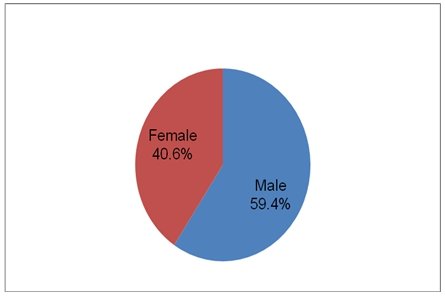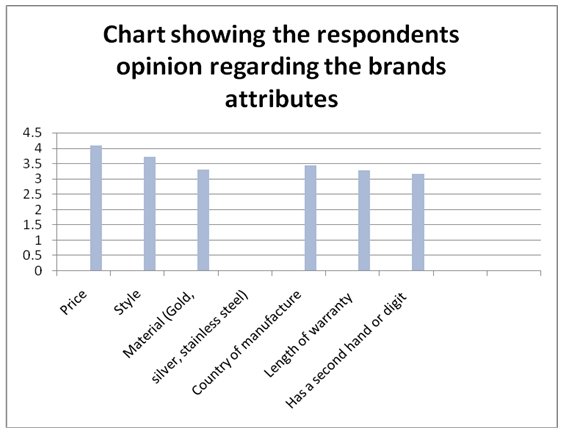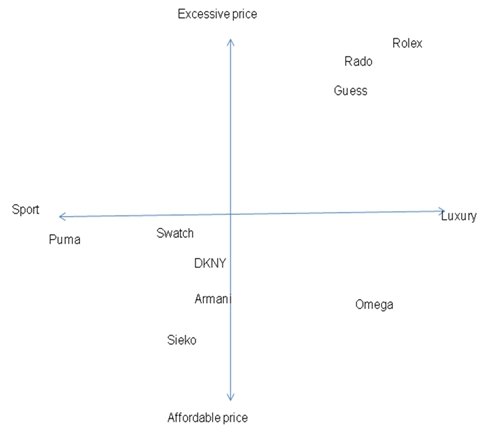Abstract
This report entails an illustration of the concept of marketing research and perceptual mapping. The report is organized into a number of sections. In the first section, the report introduces the purpose of the study. The background section gives the definition of perceptual maps together with their benefits to organisations. The report focuses on a number of attributes associated with wrist watches. These include price and style.
In order to develop a comprehensive understanding on the consumer’s variation in their perception, the report focuses on various brands of wrist watches. These include Rado, Guess, Swatch, Omega, Rolex, Puma, DKNY, Armani, and Sieko. To gain a real market opinion regarding the consumer’s perception regarding these brands, the report has taken into consideration a market survey on 64 respondents. Primary method of data collection was used in conducting the survey.
To ensure ease in the process of data collection, the report has illustrated the tool of data collection used. This entailed use of freeonlinesurveys.com. The data analysis section outlines how the data collected was analyzed and presented. Finally, the report gives a conclusion and a number of recommendations.
Introduction
To develop a comprehensive understanding on how the consumers perceive the various brands of wrist watches, I undertook a marketing research that focused on various brands of wrist watches.
The study also integrated the concept of perceptual mapping so as to understand the consumer’s perception regarding the various brands of wrist watches. The purpose of this research is to evaluate the consumers’ perception regarding various brands wrist watches. This is attained by considering a number of attributes associated with the wrist watches.
Background to the study
Perceptual maps are important tools in firms’ effort to develop effective marketing strategies. Developing perceptual maps entail charting the various attributes that consumers associate particular brands with (Lamb, Hair & McDaniel, 2011, p. 280). Perceptual maps enable firms management teams to understand the most important attributes that consumers consider in their decision making process.
Perceptual maps are also beneficial in that they enable a firm’s management team to understand the position of its brand on the consumers’ minds. This means that firms’ management teams gain knowledge regarding the competitive strength of their brands and who their core competitors are. Additionally, perceptual maps also enable firms to identify opportunities which they can exploit to increase their competitiveness.
Data collection
In the process of collecting the data two surveys were conducted. The 1st survey was aiamed at generating a general overview of the entire market regarding the various attributes. A total of 64 respondents were interviewed. Of these respondents, 59.4% of them were male while 40.3% were female.
The 2nd survey was aimed at developing an understanding of the consumers’ perception regarding the 9 brands selected with regard to price and style. The group selected these two attributes because most of the respondents focused on them. A total of 67 respondents were interviewed where 59.7% of them were male and 40.3% female. The opinions of the respondents in the 2nd survey were used to develop the perceptual map.

Figure 1: Respondents for the 1st survey.

Figure 2: Respondents for the 2nd survey
To aid in the process of data collection, an open-ended questionnaire was developed. The questionnaire was composed of three questions. The first question requested the customers to outline their gender while the second question required the respondents to rank the attributes of the wrist watches based on the level of importance attached when they first purchased their wrist watch. A number of attributes associated with wrist watches were considered.
These included the brands price, style, and material used to make it, country of manufacture, length of warranty and whether it has a second hand or digit. On the other hand, the third question requested the customers to list the various brands of wrist watches that they are familiar with. These questionnaires were also used to collect data on the 9 brands on the basis of the two attributes (price and style).
Data analysis
The data collected from the field was analyzed in so as to ensure ease of interpretation. This was achieved by using a number of data analysis techniques. Through data analysis, it was possible to illustrate the perception of the various brands of wrist watch in the consumers’ minds.
The study evaluated 9 of the most mentioned brands of wrist watches. Considering the fact that the data collected was qualitative in nature, quantitative method of data analysis was integrated. This entailed representing the respondents’ opinion on the 9 brands with regard to price and style on bar graphs.
Integration of quantitative method of data analysis resulted into ease of interpretation of the research findings. The graph below illustrate the respondents’ opinion regarding the price, style, material used to make the product, country of manufacture, length of warranty and whether it has a second hand or digit. The attributes are ranked on a scale of 5 points.

Figure 3: Chart showing the respondents opinion regarding the brands attributes
The responses of 67online respondents in the 2nd survey were considered in developing the perceptual map. From the data collection process, a list of various brands of wrist watches was developed. However, to illustrate the concept of perceptual mapping, we focused at only two attributes which included price and style. As a result, the developed a list of the most mentioned brands of wrist watches on the basis of price and style.
The main brands selected included Rado, Guess, Swatch, Omega, Rolex, Puma, DKNY, Armani and Seiko. In addition, a five point scale was developed to rank the selected brands on the basis of the two attributes. With regard to price, a scale of 5 points was developed where 1 represented affordable price while 5 represented excessive price. Similarly, a scale of 5 points was used to measure the brands style where 1 represented sport brand while 5 represented a luxury brand.
The average of the respondents’ opinion regarding each brand on the basis of the two attributes was calculated and is illustrated in the attachment labeled ‘Research For Marketing Research and Perceptual Maps’. The averages were then ranked on a 5 point scale and then used to develop the perceptual map. The price attribute was plotted on the vertical axis and style on the horizontal axis. The figure below illustrates the resulting perceptual map.

Figure 4: Perceptual map of various brands of wrist watch
The perceptual map above illustrates the position of the 9 brands of wrist watches on the basis of price and style. From the perceptual map above, Rolex, Rado and Guess brands are positioned highest in the quadrant. This means that they are perceived as the most luxurious and highly priced wrist watch.
Therefore, their competitiveness within the wrist watch market is relatively high. Omega is considered to be relatively luxurious and affordable as indicated by its position in the perceptual map. On the other hand, Puma and Swatch brands are considered to be the most affordable and sporty while Armani and Sieko are relatively sporty and affordable.
Conclusion and recommendations
The above market research has revealed that consumers have different perceptions regarding brands of wrist watches. The perception formed regarding a particular product influences the consumers in their decision making process. From the analysis, one can conclude that consumers are likely to select their preferred wrist watch on the basis of their social status and lifestyle. For example, consumers who have a high social status and lifestyle are likely to select Rolex, Rado and Guess brands.
In order for firms to position their products and services more effectively in the market, it is paramount that they incorporate the concept of perceptual mapping. This will enhance their effectiveness with which they implement product develop and improvement processes.
Additionally, the firms should also incorporate the concept of perceptual mapping in the process of developing their marketing strategies such as advertising. This arises from the fact that the firm will be able to identify the consumer’s perception regarding its products. The resultant effect is that the firm will enhance its competitiveness in the market.
Reference
Lamb, C., Hair, J., & McDaniel, C. (2011). Essentials of marketing. Mason, Ohio: South-Western Cengage Learning.